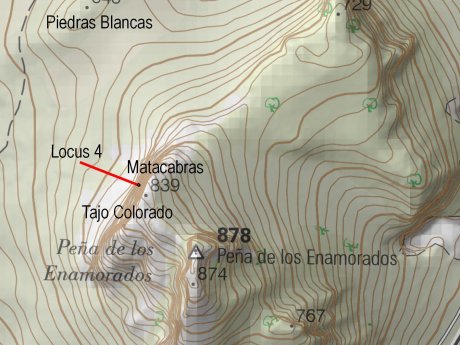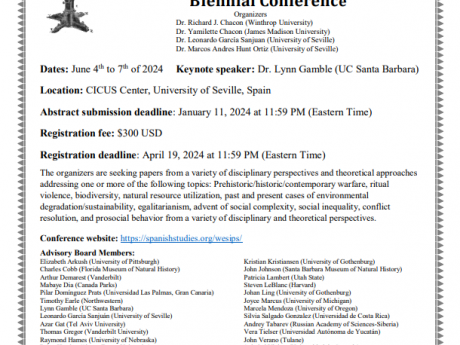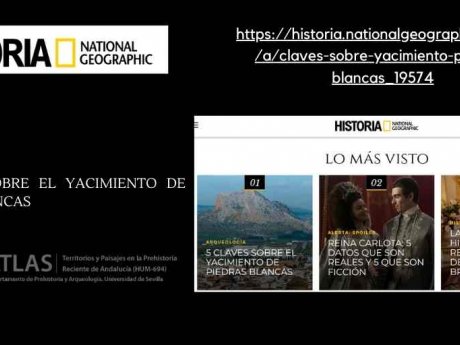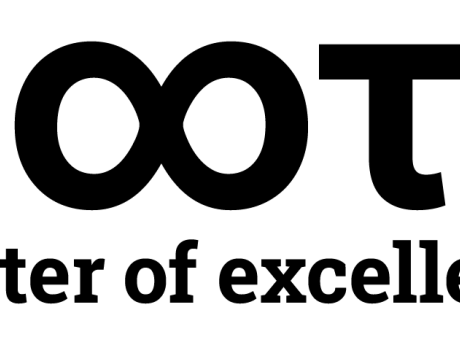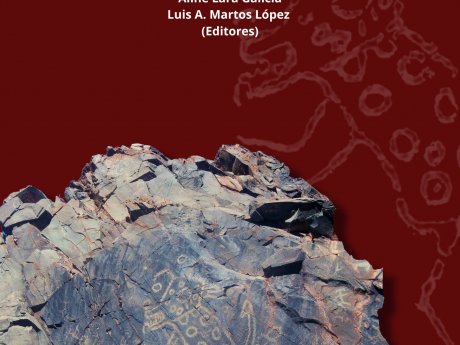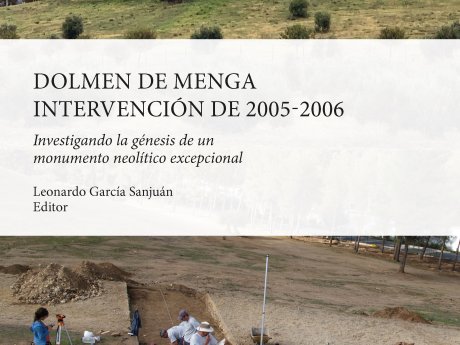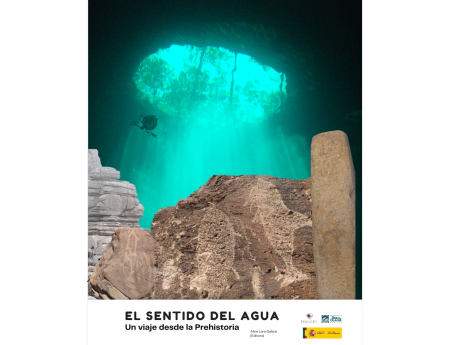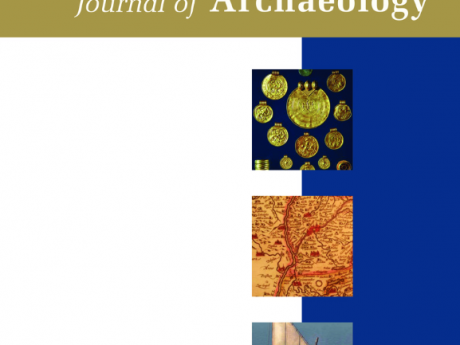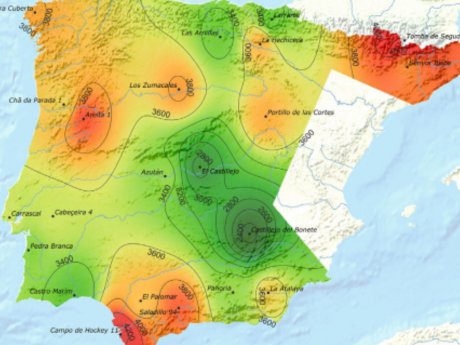Noticias |
Sounds from a Mountain. Acoustics at La Peña de los Enamorados (Antequera, Spain)
La Pena de los Enamorados, a limestone massif located in Antequera, Spain, is a famous landmark since (at least) the Middle Ages on account of its marked anthropomorphic silhouette and geographic position right at the crossroads of Andalucía’s two main communication routes (connecting Malaga ´ and Cordoba, ´ in a South-North direction, and Sevilla and Granada in a West-East direction). In the last fifteen years,...
In the bosom of the Earth: a new megalithic monument at the Antequera World Heritage Site
Antequera in southern Spain is widely recognised as an outstanding example of the European megalithic phenomenon. One of its most remarkable features is the evident relationship between conspicuous natural formations and human-built monuments. Here, the authors report the results of their investigation of a tomb newly discovered at the site of Piedras Blancas at the foot of La Peña de los Enamorados, a limestone massif...
Amelogenin peptide analyses reveal female leadership in Copper Age Iberia (c. 2900–2650 BC)
Given the absence of written records, the main source of information available to analyze gender inequalities in early complex societies is the human body itself. And yet, for decades, archaeologists have struggled with the sex estimation of poorly preserved human remains. Here we present an exceptional case study that shows how ground-breaking new scientifc methods may address this problem. Through the analysis of sexually dimorphic...
WESIPS 2024 Warfare, Environment, Social Inequality, and Pro-Sociability Biennial Conference
The organizers are seeking papers from a variety of disciplinary perspectives and theoretical approaches addressing one or more of the following topics: Prehistoric/historic/contemporary warfare, ritual violence, biodiversity, natural resource utilization, past and present cases of environmental degradation/sustainability, egalitarianism, advent of social complexity, social inequality, conflict resolution, and prosocial behavior from a variety of disciplinary and theoretical perspectives. Organizers Dr. Richard J. Chacon (Winthrop University) Dr....
Cinco claves sobre el extraordinario yacimiento de Piedras Blancas, cerca de Antequera: el tema más leído en National Geographic
El artículo de divulgación del proyecto de Piedras Blancas en Antequera, en la revista #Historia de #NationalGeographic, ha sido la más leída en esta semana. La investigación en torno al complejo funerario publicado en Antiquity, revela que fue construido en parte por las manos del hombre, aprovechando la roca natural, hace aproximadamente unos 5.000 años. Más información en: Historia National Geographic Artículo científico en Antiquity
Conferencia en el MAN: Mujeres y Poder en la Prehistoria: “La señora del Marfil”
El próximo jueves 25 de mayo en el Museo Arqueológico Nacional (Madrid), se dictará la conferencia: Mujeres y Poder en la Prehistoria. La "Señora del Marfil" del Mega-Sitio de la Edad del Cobre de Valencina, impartida por Marta Cintas Peña y Leonardo García Sanjuán. Lugar: Salón de Actos, Museo Arqueológico Nacional (Madrid) 18:30 h
Concurrimos a la 3ª edición del Premio Nacional de Arqueología y Paleontología de la Fundación PALARQ
Con el proyecto Gigantes de la Prehistoria. Megalitismo y Complejidad Social Temprana en Antequera y Valencina concurrimos en el Premio Nacional de Arqueología y Paleontología Fundación PALARQ, cuyo objetivo es reconocer la excelencia y originalidad de proyectos arqueológicos y paleontológicos liderados por equipos de investigación españoles. Más información: Fundación PALARQ
Working with the Roots Cluster, Kiel University
Leonardo García Sanjuan is a new JMA-Chair in the ROOTS Cluster of Excellence at the University of Kiel in Germany (during the spring 2023). The research of our colleague Leonardo Garcia will focus on various topics, such as early social complexity, funerary practices, megalithic monuments and prehistoric landscapes, with special attention to Late Neolithic, Copper Age and Bronze Age Iberia. More information: https://www.cluster-roots.uni-kiel.de/en/news/we-welcome-leonardo-garcia-sanjuan-as-new-jma-chair
New Book: Territorios Rupestres en América Latina
We have published the book "Territorios Rupestres en América Latina" The book edited por Aline Lara Galicia y Luis Martos López, brings together rock art research in different American countries. Publisher by Universidad Pablo de Olavide-ENREDRAS. Free download: https://rio.upo.es/xmlui/handle/10433/15715
Book presentation in the Municipal Museum of Antequera
On February 2 was presented the book "Dolmen de Menga intervention 2005-2006. Investigating the genesis of an exceptional Neolithic monument", a book that presents the work carried out by the ATLAS group and institutional collaborations of national and international researchers. The speakers at the event were: Juan Rosas Gallardo, Councilman of World Heritage of the City Council of Antequera; Manuel Pimentel Siles, Editor of Almuzara...
New Book: Dolmen de Menga: Intervención de 2005-2006
We have published the book Dolmen de Menga: Intervention 2005-2006. Investigando la Génesis de un Monumento Neolítico Excepcional (Seville, Editorial Universidad de Sevilla and Almuzara Universidad, 2022). The book edited by Leonardo García Sanjuán, with a foreword by Professor Antonio Gilman and preamble by Manuel Pimentel, brings together interdisciplinary research from the excavations carried out at the dolmen between 2005 and 2006 More information at:...
New Publication: The Sense of Water: A Journey from Prehistory
We have published a book of interdisciplinary scientific dissemination, about some evidence about the cult of water among humans and the link with the oceans from the past to the present. Download
Most read: Gender Inequalities in Neolithic Iberia: A Multi-Proxy Approach
Nuestro paper "Gender Inequalities in Neolithic Iberia: A Multi-Proxy Approach", publicado en 2019 en European Journal of Archaeology (factor de impacto 1,85), tras tres años en el top ten de los artículos más leídos de esa revista Más información
Conferencia: Metal trade between the Atlantic north and Iberia 1300- 700 BC
Los investigadores Prof. Johan Ling y Dr. Cecilia Lindhé de la Universidad de Gothenburg presentarán la conferencia "Metal trade between the Atlantic north and Iberia 1300- 700 BC" Lunes 5 de diciembre 12 h Aula Carriazo Facultad de Geografía e Historia
Seminario: LIDAR en Arqueología: avances, problemas y acciones
Seminario entorno a la tecnología LIDAR en Arqueología, sus avances, sus problemas y sus acciones. participa Francisco Sánchez, Universidad de Sevilla y Antonio Monterroso, Universidad de Córdoba 24 de noviembre 18 a 20h Sala Carriazo de la Facultad de Geografía e Historia Universidad de Sevilla
Megalithisation of Iberia
We publish a new article titled "The “Megalithisation” of Iberia: A Spatio-Temporal Model". In the last 20 years, the growing availability of radiometric data has led to profound changes in the archaeological study of cultural and social processes in European Late Prehistory. In this paper, we examine how the combined use of spatial analysis and Bayesian modelling can further contribute to an enhanced interpretation of the...
